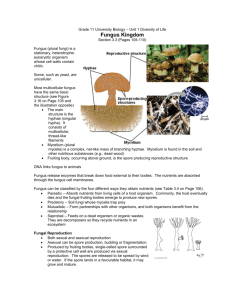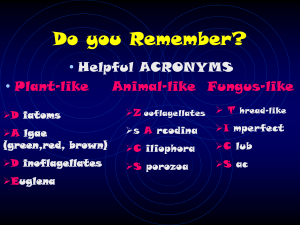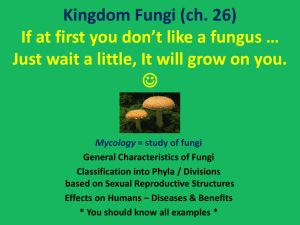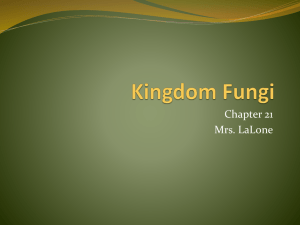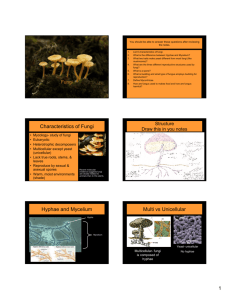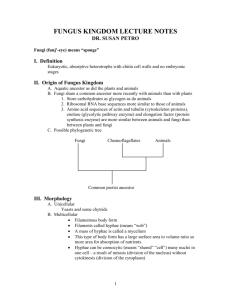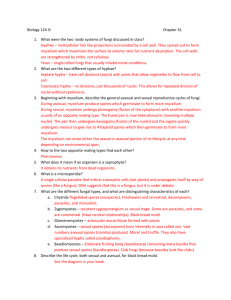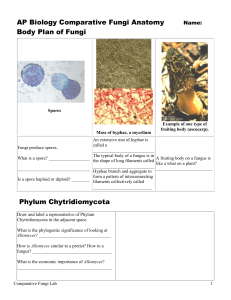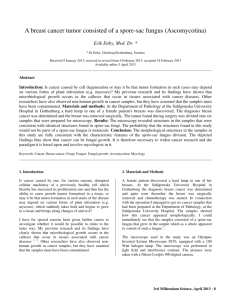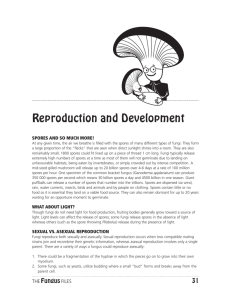Name: ___KEY______ Date: ______ Fungi Review Key A. Each of
advertisement
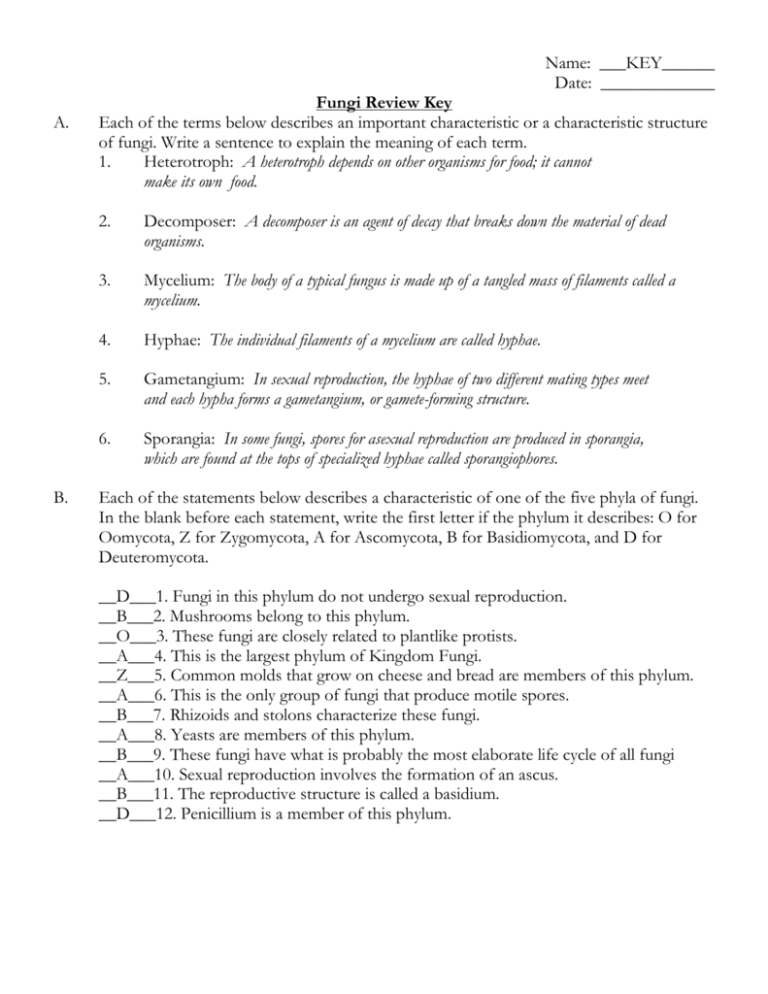
Name: ___KEY______ Date: _____________ A. B. Fungi Review Key Each of the terms below describes an important characteristic or a characteristic structure of fungi. Write a sentence to explain the meaning of each term. 1. Heterotroph: A heterotroph depends on other organisms for food; it cannot make its own food. 2. Decomposer: A decomposer is an agent of decay that breaks down the material of dead organisms. 3. Mycelium: The body of a typical fungus is made up of a tangled mass of filaments called a mycelium. 4. Hyphae: The individual filaments of a mycelium are called hyphae. 5. Gametangium: In sexual reproduction, the hyphae of two different mating types meet and each hypha forms a gametangium, or gamete-forming structure. 6. Sporangia: In some fungi, spores for asexual reproduction are produced in sporangia, which are found at the tops of specialized hyphae called sporangiophores. Each of the statements below describes a characteristic of one of the five phyla of fungi. In the blank before each statement, write the first letter if the phylum it describes: O for Oomycota, Z for Zygomycota, A for Ascomycota, B for Basidiomycota, and D for Deuteromycota. __D___1. Fungi in this phylum do not undergo sexual reproduction. __B___2. Mushrooms belong to this phylum. __O___3. These fungi are closely related to plantlike protists. __A___4. This is the largest phylum of Kingdom Fungi. __Z___5. Common molds that grow on cheese and bread are members of this phylum. __A___6. This is the only group of fungi that produce motile spores. __B___7. Rhizoids and stolons characterize these fungi. __A___8. Yeasts are members of this phylum. __B___9. These fungi have what is probably the most elaborate life cycle of all fungi __A___10. Sexual reproduction involves the formation of an ascus. __B___11. The reproductive structure is called a basidium. __D___12. Penicillium is a member of this phylum. C. D. The diagram below shows the life cycle of black bread mold, a zygomycete. Refer to the diagram as you answer the questions. 1. Three specialized types of hyphae are shown in the diagram. Name each one and describe its function. Rhizoids anchor the fungus to the bread; stolons run along the surface of the bread and give rise to the two mating types; sporangiophores give rise at their tips to sporangia, which produce spores. 2. Which part of the diagram shows asexual reproduction? The part of the cycle on the left-hand side 3. Explain what happens in asexual reproduction. Spores are released by the sporangia; under favorable conditions the spores will germinate, producing new masses of hyphae. 4. Which part of the diagram shows sexual reproduction? The part of the cycle on the right-hand side 5. Explain what is happening in section A of the cycle. Gametangia from the two mating types are fusing to form a zygospore. 6. What is the advantage of sexual reproduction over asexual reproduction? Sexual reproduction produces new combinations of genetic material. Each of the statements below describes a situation in which a fungus is playing an important role. Read each statement, then describe the role of the fungus. If possible, identify the particular type of fungus involved. 1. You open the refrigerator planning to enjoy some of the raspberries you bought the day before but discover that most of the berries are covered with an unappetizing white fuzz. The raspberries have been ruined by a type of fungus called mildew, which affects fruits. 2. A mass of tangled whitish threads known as reindeer moss grow in the arctic tundra, where most plants are scarce. This organism serves as food for reindeer, who might otherwise go hungry. The organism is a lichen, which consists of a symbiotic relationship between a fungus and a photosynthetic organism. 3. Although strep throat was at one time a life-threatening disease, this illness can now be treated effectively with an antibiotic that destroys pathogenic bacteria. The antibiotic is penicillin, which is derived from the fungus Penicillium. 4. The odor of rotting meat comes not from a decaying carcass but from a living organism that looks like a lacy ball growing out of the ground. The organism is a stinkhorn fungus, which secretes this rotten-smelling fluid to attract the flies that facilitate the dispersal of spores. 5. A flat piece of dough left for a time in a warm place begins to expand, resulting in a mound that is three or four times as high as the original dough. The fungus yeast is in the dough, causing the dough to rise. 6. The roots of a plant that produces beautiful lavender orchids are covered with a network of tiny fibers. The fibers are the hyphae of fungi that join with the orchid in a symbiotic relationship called mycorrhizae. 7. A few days after showering in the locker room of a public swimming pool, you discover several red, inflamed sores between your toes. You have contracted athlete's foot, which is caused by a deuteromycete. 8. In France, a domestic pig is taken over the countryside to search for a delicacy that will be sold to restaurants and gourmet shops. The pig is searching for truffles, a type of fungus that is a highly desirable food item. 9. Between 1845 and 1860, a third of Ireland's population starved to death because of a shortage of potatoes, the principal food crop. Potato crops were destroyed by an oomycete fungus that causes potato blight. 10. A farmer destroys all the barberry plants within the vicinity of his farm in order to protect his wheat plants from disease and death. The farmer is protecting his plants against wheat rust, a disease caused by a basidiomycete that begins its life cycle in the barberry plant.

